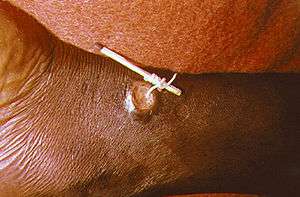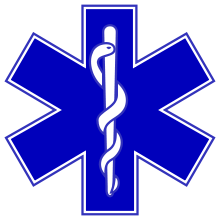Rod of Asclepius
In Greek mythology, the Rod of Asclepius (Greek: Ράβδος του Ασκληπιού, Rábdos tou Asklipioú, sometimes also spelled Asklepios or Asclepius), also known as the Staff of Aesculapius and as the asklepian,[1] is a serpent-entwined rod wielded by the Greek god Asclepius, a deity associated with healing and medicine. The symbol has continued to be used in modern times, where it is associated with medicine and health care, yet frequently confused with the staff of the god Hermes, the caduceus. Theories have been proposed about the Greek origin of the symbol and its implications.

Greek mythology and Greek society
The Rod of Asclepius takes its name from the Greek god Asclepius, a deity associated with healing and medicinal arts in Greek mythology. Asclepius' attributes, the snake and the staff, sometimes depicted separately in antiquity, are combined in this symbol.[2]
The most famous temple of Asclepius was at Epidaurus in north-eastern Peloponnese. Another famous healing temple (or asclepeion) was located on the island of Kos, where Hippocrates, the legendary "father of medicine", may have begun his career. Other asclepieia were situated in Trikala, Gortys (Arcadia), and Pergamum in Asia.
In honor of Asclepius, a particular type of non-venomous snake was often used in healing rituals, and these snakes – the Aesculapian snakes – crawled around freely on the floor in dormitories where the sick and injured slept. These snakes were introduced at the founding of each new temple of Asclepius throughout the classical world. From about 300 BCE onwards, the cult of Asclepius grew very popular and pilgrims flocked to his healing temples (Asclepieia) to be cured of their ills. Ritual purification would be followed by offerings or sacrifices to the god (according to means), and the supplicant would then spend the night in the holiest part of the sanctuary – the abaton (or adyton). Any dreams or visions would be reported to a priest who would prescribe the appropriate therapy by a process of interpretation.[3] Some healing temples also used sacred dogs to lick the wounds of sick petitioners.[4]
The original Hippocratic Oath began with the invocation "I swear by Apollo the Physician and by Asclepius and by Hygieia and Panacea and by all the gods ..."[4]
The serpent and the staff appear to have been separate symbols that were combined at some point in the development of the Asclepian cult.[5] The significance of the serpent has been interpreted in many ways; sometimes the shedding of skin and renewal is emphasized as symbolizing rejuvenation,[6] while other assessments center on the serpent as a symbol that unites and expresses the dual nature of the work of the physician, who deals with life and death, sickness and health.[7] The ambiguity of the serpent as a symbol, and the contradictions it is thought to represent, reflect the ambiguity of the use of drugs,[8] which can help or harm, as reflected in the meaning of the term pharmakon, which meant "drug", "medicine", and "poison" in ancient Greek.[9] Products deriving from the bodies of snakes were known to have medicinal properties in ancient times, and in ancient Greece, at least some were aware that snake venom that might be fatal if it entered the bloodstream could often be imbibed. Snake venom appears to have been 'prescribed' in some cases as a form of therapy.[10]
The staff has also been variously interpreted. One view is that it, like the serpent, "conveyed notions of resurrection and healing", while another (not necessarily incompatible) is that the staff was a walking stick associated with itinerant physicians.[11] Cornutus, a Greek philosopher probably active in the first century CE, in the Theologiae Graecae Compendium (Ch. 33) offers a view of the significance of both snake and staff:
Asclepius derived his name from healing soothingly and from deferring the withering that comes with death. For this reason, therefore, they give him a serpent as an attribute, indicating that those who avail themselves of medical science undergo a process similar to the serpent in that they, as it were, grow young again after illnesses and slough off old age; also because the serpent is a sign of attention, much of which is required in medical treatments. The staff also seems to be a symbol of some similar thing. For by means of this it is set before our minds that unless we are supported by such inventions as these, in so far as falling continually into sickness is concerned, stumbling along we would fall even sooner than necessary.[12]
In any case, the two symbols certainly merged in antiquity as representations of the snake coiled about the staff are common. It has been claimed that the snake wrapped around the staff was a species of rat snake, Elaphe longissima, the Aesculapian snake.[13]
Theories

Some commentators have interpreted the symbol as a direct representation of traditional treatment of dracunculiasis, the Guinea worm disease.[14] The worm emerges from painful ulcerous blisters. The blisters burn, causing the patient to immerse the affected area in water to cool and soothe it. The worm senses the temperature change and discharges its larvae into the water. The traditional treatment was to slowly pull the worm out of the wound over a period of hours to weeks and wind it around a stick.[14][15] The modern treatment may replace the stick with a piece of sterile gauze, but is otherwise largely identical.[16]
Additionally, in the biblical Book of Numbers, the Nehushtan (or Nohestan) (Hebrew: נחושתן or נחש הנחושת) was a bronze serpent on a pole which God told Moses to erect in order to protect the Israelites who saw it from dying from the bites of the "fiery serpents", which God had sent to punish them for speaking against Him and Moses. King Hezekiah later instituted a religious iconoclastic reform and destroyed "the brazen serpent that Moses had made; for unto those days the children of Israel did burn incense to it; and it was called Nehushtan" (2 Kings 18:4). Many bible students have made the connection between the Rod of Asclepius and the Nehustan, where the stick and serpent were put together in the biblical incident of mass healing. Possibly this was the reason the ancients started to use the snake in this way. The Biblical account is also the earliest known mention of the symbol.[17]
Modern use


A number of organizations and services use the rod of Asclepius as their logo, or part of their logo. These include:
Asia
- Academy of Medicine of Malaysia
- Beijing University of Chinese Medicine
- Chinese Medical Association
- India Institute of Medical Science
- Dental Council of India
- Indonesia Society for Health Promotors and Educators
- International Medical University, Malaysia
- Malaysian Medical Council
- Ministry of Health and Welfare, Republic of China
- Ministry of Health of the People's Republic of China
- Medical Council of India
- Pakistan Army Medical Corps
- Sultan Qaboos University Hospital
South Pacific
- Australian Medical Association
- Australian Medical Students' Association
- Australian Veterinary Association
- BHP Emergency Services (West Australian Iron Ore)
- Medical Council of New Zealand
- Royal New Zealand Army Medical Corps
- Royal Australian Army Medical Corps
Canada
- Ambulance Paramedics of British Columbia
- Canadian Association of Physician Assistants
- Canadian Dental Association
- Canadian Medical Association
- Medical Council of Canada
- Royal Canadian Medical Service
Europe
- Association of Anaesthetists of Great Britain and Ireland
- British Medical Association
- British Royal Army Medical Corps
- British Small Animal Veterinary Association
- Emergency medical services in France (SAMU, SMUR, et al.)
- Emergency medical services in Italy
- Emergency medical services in the Netherlands
- Emergency medical services in the United Kingdom
- Emergency medical services in Portugal
- Finnish Medical Association
- The London Clinic
- Royal College of Psychiatrists (UK)
- Spanish National Council of Medical Student's Association (CEEM)
- University of Copenhagen Faculty of Health and Medical Sciences
- Państowe Ratownictwie Medyczne – Polish emergency rescue service
Nigeria
- Nigerian Medical Association
Kenya
- Kenya Medical Research Institute
- Kenya Medical Training College
South Africa
- South African Medical Research Council former coat of arms
- South African Military Health Service
- Tygerberg Academic Hospital, Cape Town, South Africa
United States
- Alabama College of Osteopathic Medicine
- American Academy of Family Physicians
- American Academy of Psychiatry and the Law
- American Academy of Physician Assistants
- American College of Occupational & Environmental Medicine
- American College of Osteopathic Internists
- American Hippocratic Registry
- American Medical Association
- American Medical Response
- American Medical Student Association
- American Osteopathic Association
- American Veterinary Medical Association
- Army Medical Department of the U.S. Army (AMEDD)
- Blue Cross Blue Shield Association (U.S.)
- Heritage College of Osteopathic Medicine
- Hofstra School of Medicine
- International Medical Corps
- MedicAlert (U.S.)
- Michigan State Medical Society
- National Athletic Trainers Association
- New York University School of Medicine
- Stanford University School of Medicine
- Kansas City University of Medicine and Biosciences
- Pennsylvania Department of Health
- Student Osteopathic Medical Association (U.S.)
- United States Navy Hospital Corps
- United States Air Force Medical Corps
- University of Minnesota Medical School
- Yale University School of Medicine
Worldwide
- Medical Protection Society
- Star of Life, symbol of emergency medical services
- World Health Organization
Confusion with the caduceus

It is relatively common, especially in the United States, to find the caduceus, with its two snakes and wings, used as a symbol of medicine instead of the Rod of Asclepius, with only a single snake. This usage was popularised largely as a result of the adoption of the caduceus as its insignia by the U.S. Army Medical Corps in 1902 at the insistence of a single officer (though there are conflicting claims as to whether this was Capt. Frederick P. Reynolds or Col. John R. van Hoff).[18][19]
The Rod of Asclepius is the dominant symbol for professional healthcare associations in the United States. One survey found that 62% of professional healthcare associations used the rod of Asclepius as their symbol.[20] The same survey found that 76% of commercial healthcare organizations used the Caduceus symbol. The author of the study suggests the difference exists because professional associations are more likely to have a real understanding of the two symbols, whereas commercial organizations are more likely to be concerned with the visual impact a symbol will have in selling their products.
The long-standing and abundantly attested historical associations of the caduceus with commerce are considered by many to be inappropriate in a symbol used by those engaged in the healing arts.[19] This has occasioned significant criticism of the use of the caduceus in a medical context.
As god of the high-road and the market-place Hermes was perhaps above all else the patron of commerce and the fat purse: as a corollary, he was the special protector of the traveling salesman. As spokesman for the gods, he not only brought peace on earth (occasionally even the peace of death), but his silver-tongued eloquence could always make the worse appear the better cause.[21] From this latter point of view, would not his symbol be suitable for certain Congressmen, all medical quacks, book agents and purveyors of vacuum cleaners, rather than for the straight-thinking, straight-speaking therapeutist? As conductor of the dead to their subterranean abode, his emblem would seem more appropriate on a hearse than on a physician's car.
— Stuart L. Tyson
Unicode
The Rod of Asclepius has a code point in the Miscellaneous Symbols table of the Unicode Standard, at U+2695 ⚕ STAFF OF AESCULAPIUS.[lower-alpha 1]
Notes
- Some fonts, such the default in Chrome OS, show a Star of Life (a six-bar star overlaid with the Staff of Asclepius) rather than just the staff itself.
References
- Wilcox, Robert A; Whitham, Emma M (15 April 2003). "The symbol of modern medicine: why one snake is more than two". Annals of Internal Medicine. 138: 673–7. doi:10.7326/0003-4819-138-8-200304150-00016. PMID 12693891. Retrieved 15 June 2007.
- See for example Pausanias, Description of Greece 2.26.1–28.1 (here translated by Jones) 2nd A.D.: "The image of Asklepios is, in size, half as big as Zeus Olympios at Athens, and is made of ivory and gold. An inscription tells us that the artist was Thrasymedes, a Parian, son of Arignotos. The god is sitting on a seat grasping a staff; the other hand he is holding above the head of the serpent."
- Sigerist. Chapter 3, Religious medicine: Asclepius and his cult, p. 63ff.
- Farnell, Chapter 10, "The Cult of Asklepios" (pp. 234–279)
- Stephen Lock, John M. Last, George Dunea, The Oxford Illustrated Companion To Medicine, 2001, p261 "In early statues of Asclepius the rod and serpent were represented separately."
- "Asklepios' reptile was a healing creature: in ancient mythology the snake, whose skin was shed and rejuvenated, symbolized eternity and restoration of life and health" Albert R. Jonsen, The New Medicine and the Old Ethics, Harvard University Press, 1990, p122; this interpretation was current in Antiquity, as can be seen in an account of Apollodorus: "your marvel at the serpent curling around him and say that it is the symbol of the healing art, because just as the serpent sloughs the skin of old age, so the medical art releases from illness." (in E. Edelstein and L. Edelstein (eds.), Asclepius: A Collection and Interpretation of the Testimonies, Baltimore, 1945, p12)
- "[...] the ancient conception of the serpent as the embodiment of the mystery of one absolute life of the earth, which entails a continual dying and resurrection [...] the combination of corruption and salvation, of darkness and light, of good and evil in the Asklepian symbol." Jan Schouten, The Rod and Serpent of Asklepios, Symbol of Medicine, 1967, p2
- Albert R. Jonsen, The New Medicine and the Old Ethics, Harvard University Press, 1990, p122-123
- Henry E. Sigerist, A History of Medicine, Oxford University Press, 1987, p27-28
- James A. Kelhoffer, Miracle and Mission, Mohr Siebeck, 2000, p438-439 "[...] it was known, at least by some people in antiquity, that a snake's venom is not harmful if imbibed, but rather only if it enters directly into a person's blood stream. For example, the first-century CE historian Lucan writes that the younger Cato, when leading his troops through Libya during the Roman Civil War, informed his men about this very point [...] 'The poison of snakes is only deadly when mixed with the blood; their venom is in their bite, and they threaten death with their fangs. There is no death in the cup.'" He also mentions an account of Cornelius Celsus (first century CE) "'For a serpent's poison, like certain hunter's poisons..., does no harm when swallowed, but only in a wound'". "Likewise, Galen relates a rather peculiar healing by Asclepius involving viper's venom. The god appeared to a wealthy man in Pergamum and prescribed 'that he should drink every day of the drug produced from the vipers and should anoint the body from the outside.' [...] The elder Philostratus describes a similar practice of 'the wise Asclepiads,' who 'heal the bites of venomous creatures... using the virus itself as a cure of many diseases.'"
- Andre Menez, The Subtle Beast, Snakes From Myth to Medicine, 2003, p14
- Emma J. Edelstein; Ludwig Edelstein (27 February 1998). Asclepius: Collection and Interpretation of the Testimonies. Baltimore: Johns Hopkins University Press. p. 13. ISBN 0801857694.
- Gerald David Hart, Martin St. J. Forrest, Asclepius: The God of Medicine, 2000, p42
- Dickson Despommier, People, Parasites, and Plowshares: Learning from Our Body's Most Terrifying Invaders, Columbia University Press, 2016 (first edition in 2013), pp. 147–163 (chapter 7 on Dracunculus medinensis), ISBN 9780231161954.
- Blayney, Keith (July 2007) [Sep 2002]. "The Caduceus vs. the Staff of Asclepius". Alternative Journal of Nursing (14): 4.
- "Management of Guinea Worm Disease (GWD)". Centers for Disease Control and Prevention. Retrieved 1 May 2012.
- Prakash, M; Johnny, JC (2015). "Things you don't learn in medical school: Caduceus". J Pharm Bioallied Sci. 7 (77 (Suppl 1)): S49–S50. doi:10.4103/0975-7406.155794. PMC 4439707. PMID 26015747.
- F.H. Garrison, "The Use of the Caduceus in the Insignia of the Army Medical Officer", in Bull. Med. Lib. Assoc. IX (1919-20), 13-16
- Engle, Bernice (December 1929). "The Use of Mercury's Caduceus as a Medical Emblem"". The Classical Journal. 25 (1): 205.
- Friedlander, Walter J (1992). The Golden Wand of Medicine: A History of the Caduceus symbol in medicine. Greenwood Press. ISBN 0-313-28023-1.
- An allusion to John Milton's description of Belial in Paradise Lost II.113-114.
External links
![]()